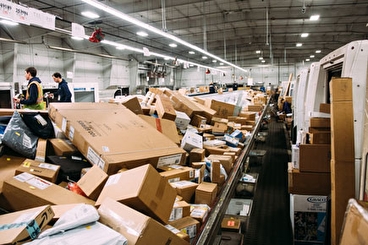
The Future of E-commerce

Saif Benjaafar, Seth Bonder Collegiate Professor of Industrial and Operations Engineering, University of MIchigan
Area of Expertise: Industrial & Systems Engineering
The growth in e-commerce (the online buying and selling of goods and services) has been explosive. In the United States, e-commerce accounted for more than 15 percent of total retail sales in 2022—a number expected to grow to nearly 25 percent by 2025. Globally, e-commerce sales are expected to reach more than $7 trillion by then, with an estimated 2.7 billion digital buyers worldwide.
E-commerce is part of a larger economic trend in which products and services are increasingly procured or accessed at a distance and on demand. Efficiencies in logistics, coupled with new modes of delivery, are enabling customers to order nearly everything from anywhere, to order frequently, and to order in smaller quantities.
The rise of e-commerce is poised to dramatically alter the urban landscape in many communities, by such means as shrinking the footprint of brick-and-mortar retail, expanding warehousing, increasing delivery vehicle traffic (adding to congestion and pollution in some cases), and increasing the commercial use of the curbside and sidewalk. E-commerce is also diminishing the reliance on commercial hubs, such as the downtown core and the suburban mall. This has the potential effect of broadening access to products and services to underserved communities, such as those in low-income and rural areas, but could also weaken economic activity in traditional centers of commerce. Additionally, this shift to e-commerce may usher in a new era in which people travel less to access products and services.
Below we highlight several emerging trends in e-commerce that will be of particular relevance to transportation and mobility in the years to come.
The rise of e-commerce is poised to dramatically alter the urban landscape in many communities, by such means as shrinking the footprint of brick-and-mortar retail, expanding warehousing, increasing delivery vehicle traffic...and increasing the commercial use of the curbside and sidewalk.
Dark Stores and Last-mile Distribution Centers
New e-commerce business models have recently emerged, built on the promise of making home deliveries (of primarily groceries and other household products) in as little as 15 minutes. Prominent examples of such services include Gopuff, Gorrillas, and Getir. The concept behind these delivery services is novel in that it relies on a dense network of micro-warehouses, often referred to as “dark stores,” with each micro-warehouse serving an assigned area within a travel radius of mere minutes. To enable ultra-fast delivery, these services rely on a pool of dedicated drivers assigned to each micro-warehouse, with deliveries often carried by e-bike, e-scooter, or e-motorcycle. In many cases, these micro-warehouses are taking over vacant retail spaces or neighborhood convenience stores. This model is part of a larger trend focused on bringing distribution warehouses closer to the customer. These smaller warehouses embedded in residential areas are often called “last-mile distribution centers.”

Smart Lockers, Mobile Warehouses, and Airborne Fulfillment Centers
To improve the efficiency of last-mile delivery and reduce its environmental footprint, e-commerce companies are exploring alternatives to home deliveries, including deliveries to “smart lockers” often located at nearby convenience stores, transit stations, or community centers. In some cases, these efforts have involved government support and funding (e.g., Singapore has recently committed to building a countrywide network of smart lockers). Other companies are experimenting with mobile warehouses—networks of trucks used not only as delivery vehicles but also as sources of order fulfillment or as staging points for customer pickups. Amazon recently filed a patent for an “airborne fulfillment center,” a blimp-like airship from which drones fly back and forth to deliver packages below.
Drones, Sidewalk Robots, and 3D Printers
E-commerce companies are also experimenting with alternative modes of delivery. Several, including Amazon, have recently launched pilots that deploy airborne drones or sidewalk robots to handle the last step of the delivery process. While the use of airborne drones continues to face regulatory hurdles, the deployment of sidewalk robots (often a cooler-sized vehicle controlled remotely) has recently accelerated, with food delivery as the most common application (e.g., Coco, Nuro, and Scout). A technology that bypasses the physical delivery of products altogether is 3D printing. For several categories of products, it is now possible to download a digital file from an online store and have the product—such as a jewelry piece, a house ornament, or a toy—printed at home. E-commerce companies are also considering business models that, for a monthly subscription fee, provide free 3D printers to consumers.